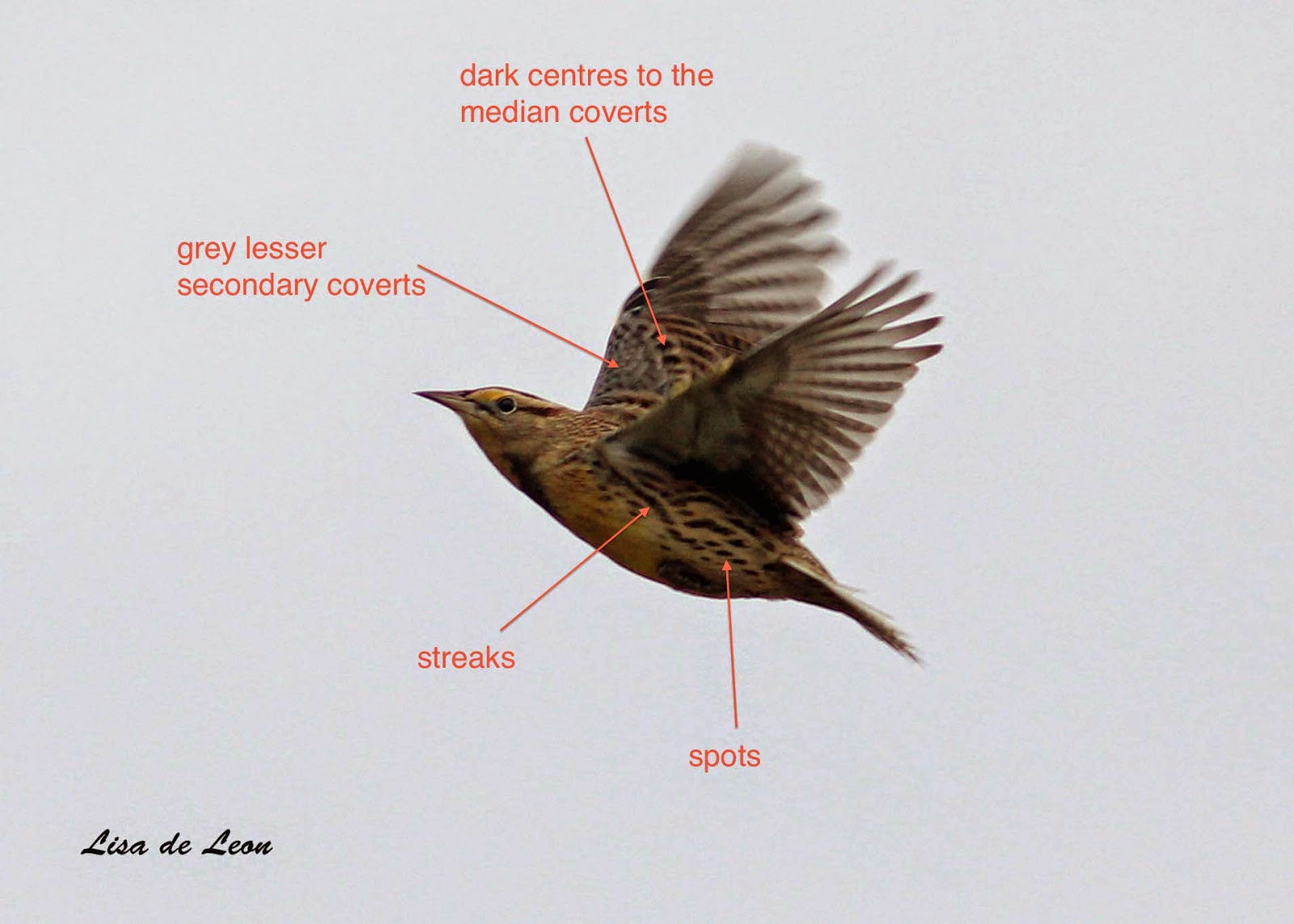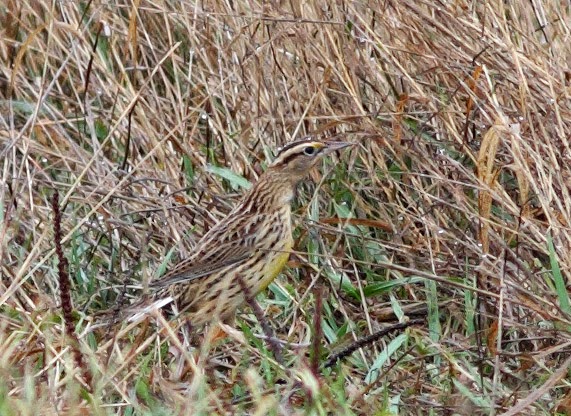Thanks go to Lisa de Leon, Ken Knowles, John Williams, and Paul Linegar for the great photos!
This photo shows why we were originally excited by this meadowlark. Limited white in the rectrices (only the outer 2.5 feathers) would seem to indicate Western Meadowlark based on the current field guides. But from talking to experts this isn't as clear-cut of a feature to distinguish the two species as was originally thought. Definitely points in a westerly direction but doesn't bring us there.
Another photo of the spread tail:
Before I go on, it's important to understand the molt patterns of meadowlarks. They exhibit a complex basic molt strategy. That jargon basically means that adults (after hatch years) have one molt per year where they replace all feathers - this happens in the fall. This is called the pre-basic molt. The only exception is that hatch year/first year meadowlarks have two molts during the autumn - called the pre-basic and pre-formative molts.
What this all means is that our bird is almost certainly in complete winter plumage and will keep these same feathers until next year in early Autumn.
A second feature often mentioned to separate Eastern from Western Meadowlarks is the extent of yellow in the malar area. All fresh Autumn meadowlarks have buffy areas to the malar which eventually wear off revealing white or yellow to the inner-half of these feathers.
Flight shots of the Newfoundland meadowlark seemed to indicate a yellow area to the malar - another indicator of Western Meadowlark. However, this is a difficult feature to objectively evaluate - especially considering that this can, apparently, be quite difficult to see on specimens in the hand let alone from individual photos.
The third feature often mentioned in the field guides is the markings on the flanks: spotting for Western, streaking for Eastern. Apparently, again, this is less than reliable - especially for Autumn birds. And to add to the confusion, some photos of the NL bird show spotting, while others show streaking....
----------------------------------------------------------------
This is where I bring in the comments from others based on our photos. Peter Pyle, Peter Burke, Alvaro Jaramillo, David Sibley, and Kevin Mclaughlin all provided comments. All said they were at least somewhat confident in their identifications. Only problem is that 3 voted for Eastern, and 2 for Western. So let's see what they said.
----------------------------------------------------------------
The Eastern camp
----------------------------------------------------------------
That being said, one of the most insightful comments came from Sibley who commented on the upper tail covert pattern: "Eastern uppertail coverts look mostly black, with a broad solid black central shaft streak and small dark bars projecting out from that. Western uppertail coverts are pale gray-brown with distinct dark bars (no dark longitudinal shaft streak). This is the same pattern difference shown on the central tail feathers, but it seems to be more obvious and more reliable on the coverts. The NL bird looks like an Eastern."
This feature can easily be seen in the following photo:
Other comments that were made by the pro-Easterners:
Without relying on relatively easy to see and objective features as those mentioned above (extent of white in tail, yellow in malar, etc) the identification criteria more or less moved into subjective criteria. Both perspectives seemed to apply their own biases to the exact same features to explain their own identification.
That being said, one of the most insightful comments came from Sibley who commented on the upper tail covert pattern: "Eastern uppertail coverts look mostly black, with a broad solid black central shaft streak and small dark bars projecting out from that. Western uppertail coverts are pale gray-brown with distinct dark bars (no dark longitudinal shaft streak). This is the same pattern difference shown on the central tail feathers, but it seems to be more obvious and more reliable on the coverts. The NL bird looks like an Eastern."
This feature can easily be seen in the following photo:
Other comments that were made by the pro-Easterners:
The bird was deemed "too dark-backed" for WEME, "with a slight warmth to the brown" indicating EAME.
"The back can look paler looking in fresh fall Easterns than in spring birds. By spring this veiling wears off, resulting in brighter colours in spring for breeding, including darker-redder backs" for EAME.
"Reddish tinge to the upper parts" is good for EAME. And "likely a female due to the dull head pattern and relatively reduced amount of white in the tail"...
"Solid stripes to the face indicates EAME". "Dark bars on the central rectrices are wide enough for EAME".
A reddish tinge to the back? A subjective observation IMO
----------------------------------------------------------------
The Western camp
----------------------------------------------------------------
----------------------------------------------------------------
It was a learning experience, and many thanks are in order for the many people who provided their insight... especially the 5 mentioned above who took the time to provide their own thorough analysis of the photos. Next time we'll be better prepared!
"My impression of the bird is that it shows the overall coloration of a fresh Western and not an Eastern."
"All the photos we see on the internet, especially of Eastern from the East, are dominated by worn spring singing males - very very few fresh plumaged birds in the fall. This fails to show how different the two are in fresh plumage aspect. Easterns are a very richly coloured bird with bright buff (quite golden to orange) edgings and rich chestnut (with reddish tones) internal colour to the mantle feathers. Westerns are distinctly paler in both regards - the edges are duller, as well as the internal colours, making them appear ‘greyer’ and lighter, or not nearly as colourful overall. A couple of the flight shots showing the dorsal side and the perched bird show the colours of a Western to me, not nearly bright and rich enough for a fresh Eastern. Although the tail pattern is problematic, I also see the thin bars of a Western compared to the broader thicker marks that an Eastern shows on the central pair. I would have liked to see the eyestripe a bit thinner than this bird’s but I don’t think its a problem."
"I think that the hybrid possibility is not of much value in this record. To me there is too much consistent with the plumage of Western to me in this bird to evoke the concern."
"Seems short-billed, somewhat supportive of a bird of the year. "
"Don’t seem to exhibit the richer buff/golden edgings nor deeper chestnut internal areas I associate with fresh Easterns. The underparts also seem to lack the brightness I associate with the fresh ventral feathers, including those that veil the yellow. The eye line is consistently thicker than I would like but I don’t think its a game changer."
"I see yellow on that malar, the tail pattern, and the bars on the wings/tail that I can see in some photos do not look to become confluent at the rachis. They stay narrow, and even width throughout the feather, which is a Western feature (at least most Westerns, the ones in the Pacific Northwest are Eastern like in this feature)."
"There is definitely yellow in the malar from what I can see. That will become bolder as the pale feather tips wear through the winter."
----------------------------------------------------------------
So there you have it, if you weren't confused before, you better be now!
It was a learning experience, and many thanks are in order for the many people who provided their insight... especially the 5 mentioned above who took the time to provide their own thorough analysis of the photos. Next time we'll be better prepared!
--------------------------------------------------------------------------------------------------
Anyone else sick of looking at meadowlark photos?!
There was a tame Queen Eider at Cape Spear yesterday:
Subject of a future blog post!














































